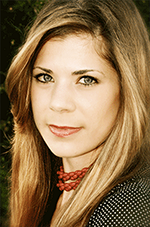
Sarah McCoy is the New York Times, USA Today, and international bestselling author of The Mapmaker’s Children; The Baker’s Daughter, a 2012 Goodreads Choice Award Best Historical Fiction nominee; the novella “The Branch of Hazel” in Grand Central; and The Time It Snowed in Puerto Rico. Her work has been featured in Real Simple, The Millions, Your Health Monthly, Huffington Post and other publications. She has taught English writing at Old Dominion University and at the University of Texas at El Paso. She calls Virginia home but presently lives with her husband, an Army physician, and their dog, Gilly, in El Paso, Texas. Connect with Sarah on Twitter at @SarahMMcCoy, on her Facebook Fan Page, Goodreads, or via her website, www.sarahmccoy.com.
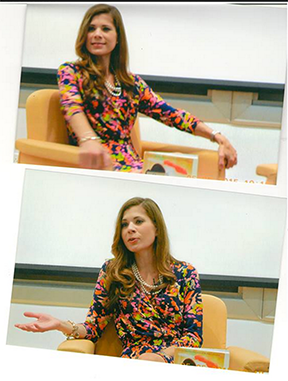 7.12.2015 Sarah McCoy: On using history as a manual for today
7.12.2015 Sarah McCoy: On using history as a manual for today

As a child growing up in a military family and a wife who married an Army husband, El Paso author Sarah McCoy has been able to live in many of the settings of her books. From visits to her mother’s relatives in Puerto Rico, to her childhood family stationed in Germany, to settling in at Fort Bliss and El Paso as an military spouse for the past eight years, she’s seen firsthand the places she writes about.
An adept and active author on social media, McCoy utilized her keyboard to answer our interview questions via email for Lone Star Listens.
LONE STAR LITERARY LIFE: First of all, Sarah McCoy, welcome to Texas. I understand that you have come to Texas because your husband is a military physician at Fort Bliss. What has surprised you about living in Texas and El Paso?
SARAH McCOY: Thanks so much for the warm welcome! I must admit, however, after living here eight years, I feel very much at home in my Texas community. We were in Norfolk, Virginia, in 2007 when my husband received orders to report to Fort Bliss. We’ve been here ever since, which has been one of the biggest surprises—to answer the second half of your question. Military personnel are typically moved around with much more frequency. I consider it a blessing that we’ve stayed for as long as we have. I’ve come to love the great Southwest, its people, stories, and culture.
How would you describe the writing community in El Paso?
In my experience, the writing community in El Paso is on par with the environment—it’s a lonesome cowboy land. Which fits me to a tee. I’m an introvert, particularly when it comes to my creative process. I hunker down in remote solitude to write. I can’t even have TV, radio, or phones on. I learned fast in MFA school that I have a hard time brainstorming in group settings. I end up investing so much of my imagination in other people’s stories that my own character voices are lost. So while I thoroughly enjoy meeting readers and other writers, championing their literary endeavors, and forging lifelong friendships, West Texas has been the perfect landscape for my personal craft development. I’m sure there are many wonderful writing groups out this way for those seeking a workshop dynamic.
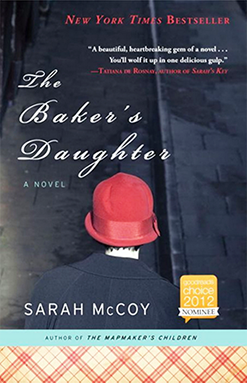 In your novel The Baker’s Daughter, memories of the Holocaust and current issues facing US Border Protection come together at the counter of a small German bakery in El Paso. The two stories—of Reba and Riki, of Elsie and Josef—blend so well. What inspired your idea for the novel?
In your novel The Baker’s Daughter, memories of the Holocaust and current issues facing US Border Protection come together at the counter of a small German bakery in El Paso. The two stories—of Reba and Riki, of Elsie and Josef—blend so well. What inspired your idea for the novel?
I spent a portion of my childhood in Germany, where my dad, a career military officer, was stationed. My husband also grew up in Germany, speaks fluent German, and worked there during his summers in college. When we first moved to El Paso, I went to a local farmer’s market and met an eighty-year-old German woman selling bread. I was completely smitten by her, and all that I imagined she might have experienced in her life. While picking out my brötchen, I asked how she came to be in El Paso. “I married an American soldier after the war,” she told me. Voila! Elsie, my 1945 protagonist, was born. My memories of living and traveling in Germany served as my imaginative landscape and fueled my curiosity regarding the country and its people during those last awful months of World War II. Teaching at the University of Texas at El Paso, I saw many of my students write about their fear and anxiety regarding the deportation of family and friends. I imagined many in Germany (Aryan, Jewish, etc.) felt similarly.
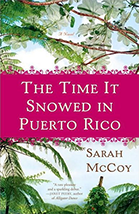 You are known for your ability to show unique perspectives of prominent historical events with all three of your books. Where does it start for you: an interest in the event, or a character behind the event?
You are known for your ability to show unique perspectives of prominent historical events with all three of your books. Where does it start for you: an interest in the event, or a character behind the event?
The inspiration for each of my novels has come to me differently. Published friends tell me how they are consistently inspired through a specific story vehicle: a historical character, political agenda, visual image, emotional struggle, color, food, etc. I can't say that I have one. My muse likes to throw her bolts in various forms. I've never had a story come to me in the same way.
The Mapmaker's Children actually began in the contemporary narrative not Sarah Brown’s historical one. I heard a sentence spoken by a woman, Eden Anderson, “A dog is not a child.” It was the way she said it that wouldn't let me be. Confident, angry, and yet deeply wounded by the very words she spoke. I couldn't shush her no matter what I did. Months of hearing this over and over in my head nearly drove me to the madhouse. That’s when I knew: this wasn’t just a passing statement, it was a character haunting. I was being summoned!
In an effort to find relief, I wrote the sentence and its corresponding scene in the journal. I realized then that the voice was echoing through and out the front door of an old house—the house in New Charlestown. It was calling me to solve its Underground Railroad mystery set between Eden Anderson in present-day West Virginia and Sarah Brown 150 years ago.
It seems like you like to write about tactile, high-touch topics: cooking in The Baker’s Daughter, and dolls/quilts/crafts in The Mapmaker’s Children. What’s your writing process like?
As so many other writers probably concede, I am a creature of wicked habit. My husband might even diagnose it as obsessive compulsivity, but kindly terms it “doggedness.” I stick to a pretty strict routine when I’m in the midst of writing a first draft. I work from the time I wake up until my husband comes home at night, taking an hour lunch break to make something hot on the stove. I use emails and social media as brain breaks if I need to get away from the imaginary realm and reflect a bit. My attraction to tactile activities is purely a reflection of the characters. I didn’t choose for the real Sarah Brown to be artist nor do I have any personal abilities to paint or draw. A stick figure is a mighty feat for me! But I threw myself into Sarah’s artistic world and allowed her to teach me how powerful it can be in catalyzing social change.
What I can speak to directly is the form of my novels. The historical-contemporary dual narrative seems to be my organic way of processing whatever fictional worlds I’m working in. History seen through this kind of Alice in Wonderland looking-glass filter of the present. I wrote that way for The Baker’s Daughter and now again in The Mapmaker’s Children. I’m riveted by how the people of the past can reach across generations and impact the present; how mysteries of the present have their solutions in the past; how issues we face and decisions we make today are strikingly similar to ones our forbearers made with good and bad outcomes. I’m spellbound by this interplay—by the impact of Sarah Brown on us, the contemporary Eden Andersons of today.
I think it’s important we don’t just read and compartmentalize the past as an “interesting story.” I want my readers to see that the history is a key, a manual, a lesson guidebook for us to learn and implement change in our present lives.
You have an MFA from Old Dominion University. How did that study help form your writing? What advice would you give to writers who don’t have the opportunity to go to graduate school?
MFA education was a life-altering experience. I learned so very much about myself as a writer; how my mind processes my stories; how I work most efficiently; and how important it is for writers to champion each other. As I mentioned earlier, this doesn’t necessarily mean plugging into a local group of writers, but it does mean that I am connected to the macro literary community. Social media has been a tremendous help in that regard, which is funny given that Twitter and Facebook were never mentioned during my graduate school years. I don’t even think they were invented yet! (I may be dating myself awfully by that statement.) But I do feel that I have a wondrous, talented group of writers and readers there whom I turn to daily for support.
My advice for writers in or out of a program is the same: Persevere. This writing life is hard. Ninety percent of your work is in solitary confinement where no one sees your toil, your tears, the sleepless nights, and writing sores from being enslaved to the story realm. And that’s exactly what you are as a writer— a slave to your characters, a minstrel to the masses, a peasant to a kingdom of critics. But if you know for certain you could not be happy doing anything else, then join the gypsy tribe and persevere.
Who gave you your first writing break and how did it occur?
Gosh, I can’t put a finger on one experience that was my pinnacle “break” into writing. My career has not been one of big, splashy firework moments. It’s been more of a mountain hike. Slow, laborious, but gratifying— working my way across the switchbacks, focusing on the path ahead, the summit above, and not letting myself stop to look behind. I’m still on the journey and wake up every morning asking for the strength to put one step in front of the other. It’s a faith walk, and all I know for certain is that every push forward puts me a little bit closer to the top than I was yesterday.
Did my “break” happen when my books were published? Or was it when my high school English teacher read one of my stories and told me she enjoyed it? Or when my mother took my first preschool “book” in hand and declared it a treasure? I don’t know. Maybe each one was a break of its own kind in its own time. Right now, I’m just looking forward to the next one.
To quote Sarah McCoy, “In the current publishing milieu . . .it is expected for authors to wear the hats of Artist, Social Media Maiden, Co-Captain of Marketing and Publicity, Chief Cheerleader, Event Hostess, Travel Agent, Chauffeur, and Self-Therapist,” how much of the business side do you get into as an author? Do you know how your books are selling? How much traffic your website gets? That sort of thing. How much of the business side would you recommend that authors learn?
I’d recommend authors learn as much of the business side as they can. It’s imperative, in my opinion. But then, I’m a woman who believes that nobody loves my book babies as much as I do simply because nobody knows my work inside and out the way I do! Having a published author career is a business: a business of selling books. Sure, we try to live in this altruistic dominion of art for art’s sake, rainbows and world peace sparkles, but the truth is that we cannot sustain literature if readers aren’t buying. It’s a business-based model. We must have reader buyers to finance publishers to produce good literature by authors.
So I think it’s a disservice to all if I, as an author, sit back and let others do whatever falls outside the creative editorial sphere: the marketing and publicity; outreach to bookstores, bloggers and book clubs; planning book tour events, travel, and accommodations; media interviews; website creation and updating, and the list grows every day as new opportunities opening up, new avenues of technology connect readers. It’s incumbent on the author to lead her publishing team’s charge on all fronts.
Which Texas writers do you read and enjoy?
I adore my Texan tribe. Author Sarah Bird and I met at the Tucson Festival of Books this year. We clicked like sisters separated at birth. She’s a phenomenal writer, part of my Army brat pack, and a straight-up gem. Author Amanda Eyre Ward is another brilliant friend in the Lone Star state. I’m praying we’ll have the chance see each other in person soon. And I’ve just been introduced to Austinite Jill Alexander Essbaum, whose wonderful debut Hausfrau recently published. Those are just a handful. It’s a big state packed with star talents!
Here’s one other thing I imagine readers will enjoy knowing. What’s in your To Be Read pile?
I’m on a reading tear this month after being in what we earlier discussed as the “business mode”—book touring for The Mapmaker’s Children March through June. I’ve finally landed in a brief vacation zone between promoting one book and writing the next. I’m gobbling every minute in hedonistic reading. I’ve just begun Paula McLain’s forthcoming novel Circling The Sun. It releases later this month. As well, I plan to dig into Kristy Logan’s debut, The Grace Keepers.
* * * * *
Praise for Sarah McCoy's novels
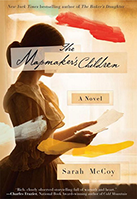
“McCoy deftly intertwines a historical tale with a modern one…lovingly constructed… passionately told….The Mapmaker’s Children not only honors the accomplishments of a little-known woman but artfully demonstrates how fate carries us in unexpected directions, no matter how we might try to map out our lives.” —The Washington Post
“McCoy carefully juxtaposes the past and the present, highlighting the characters’ true introspection, and slowly revealing the unusual similarities in the two woman’s lives, which leads to a riveting conclusion.” —Publisher's Weekly
"El Paso writer Sarah McCoy mined the archives for information about Brown’s daughter Sarah, an artist who is the titular character of her latest novel, The Mapmaker’s Children. The lacing of the two plots is seamless… [McCoy]’s unquestionably a gifted author.” —Dallas Morning News
“Linking a contemporary woman named Eden with the daughter of abolitionist John Brown is a provocative idea, and McCoy has the skills to pull off something talk-worthy.” —Library Journal, Hot Book Club Reads for Summer 2015
“Engaging and emotionally charged…Eden’s realization that ‘what fable and history could agree upon was that everyone was searching for their ever-after, whatever that may be’ neatly sums up the novel’s heart—it’s about the family and the life we create, not always the ones we imagine for ourselves.” —Kirkus Reviews
“In vibrant yet unassuming prose, McCoy tells a story of womanhood past and present, asking big questions about family, courage and love. Readers will enjoy solving the historical puzzle of the doll's origins, but the book's true strength is its portrayal of Eden and Sarah: two brave women bound together by the difficult, noble work of building worthwhile lives.”
—Shelf Awareness
“A fascinating peek into the personal life of the legendary John Brown and keep the pages turning. The Mapmaker’s Children serves as a reminder of how objects persist, such as Sarah’s doll, and how memories connected with those objects can last through generations.” —BookPage
